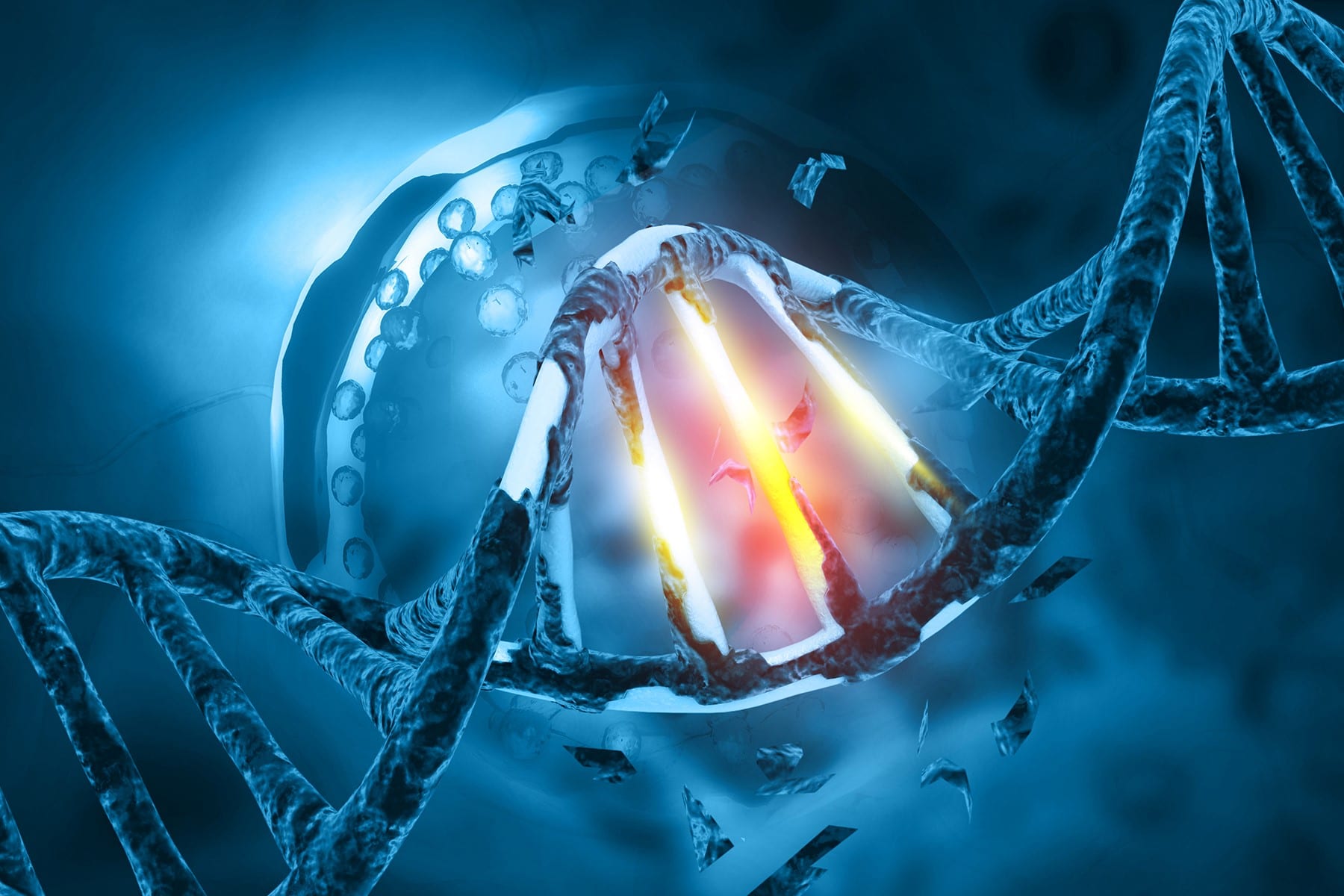
Targeting a Potential Vulnerability of Certain Cancers with DNA Damage Response
Every individual’s DNA is unique, and because of this, every patient responds differently to disease and treatment. It is astonishing how four tiny building blocks of our DNA – A, T, C, G – dictate our health, disease, and how we age.
The tricky thing about DNA is that it is constantly exposed to damage by sources such as ultraviolet light, certain chemicals, toxins, and even natural biochemical processes inside our cells.¹ If ignored, DNA damage will accumulate in replicating cells, giving rise to mutations that can lead to premature aging, cancer, and other diseases.
To combat DNA damage, our cells have a complex network called DNA damage response (DDR), which is responsible for sensing and repairing DNA ensuring genomic integrity and cell survival. This highly organized network detects damage and signals the presence of DNA damage to a complex repair machinery.² If damage is not corrected, or becomes too substantial to overcome, cells can initiate a process of programmed cell death called apoptosis.³ By doing so, they minimize the risk of propagating dangerous mutations, which could potentially transform healthy cells into cancerous cells.
In cancer, DDR becomes critical. Cells with defects in their DNA repair machinery fail to preserve their genetic integrity, and the accumulation of mutations and genetic instability is a well-recognized hallmark of cancer.⁴ Tumor cells often have mutations in one of their DNA repair pathways. This allows them to develop mutations in oncogenes, tumor suppressors or drug targets and thereby evade treatment, yet at the same time, makes them vulnerable.² One novel concept taking advantage of faulty DDR in cancer cells is synthetic lethality.
Synthetic lethality occurs when two concurrent pathway disruptions (for example, a genetic aberration and a pharmacological intervention) disable a cancer cell’s ability to repair DNA damage, resulting in its death, while normal cells with intact DDR pathways can compensate for the pharmacological blockade.⁵,⁶ Learning how to exploit these vulnerabilities may enable targeting of the ‘Achilles’ heel’ of specific cancers.
At Merck KGaA, Darmstadt, Germany, our curiosity to transform cancer care drives us to understand and explore the full potential of promising mechanisms in cancer research. DDR is one of our key mechanistic pillars of focus in oncology, and we believe it has the potential to transform standard cancer care both as monotherapy, and in combination with immunotherapy, chemotherapy or radiotherapy.
Initially, we are focusing on three targets that play important roles across several DDR pathways, ataxia telangiectasia RAD3 related (ATR), ataxia telangiectasia mutated (ATM), and DNA-dependent protein kinases (DNA-PK). We have invested significant resources into this promising approach with a focus on synthetic lethality, immune activation, and induced DNA damage. In 2017, we boosted our in-house expertise and capabilities, and licensed two DDR clinical-stage programs (an ATR and DNA-PK program) and two novel pre-clinical programs. More recently, in 2020, we embarked on a collaboration with Artios Pharma, a leading DDR company, and will use their DNA nuclease platform to identify novel inhibitors against this target class and synthetic lethal interactions to guide their optimal clinical development, further promoting synergy of our knowledge and expertise in this promising field.
Take, for example, tumor cells that have non-functional ATM, which makes them more dependent on the ATR repair pathway.⁷ Inhibitors of ATR may have potential as monotherapy against tumors with ATM loss-of-function. Furthermore, ATR is essential to manage high replication stress, for instance caused by certain oncogenes, potentially making corresponding tumors vulnerable to ATR inhibitors. Finally, when used in combination with chemotherapy or radiation, ATR inhibitors may potentially enhance the efficacy of these DNA-damaging agents.
Our lead DDR inhibitor candidate is a first-in-class ATR inhibitor. Pre-clinical data demonstrate that by enhancing replication fork collapse in solid tumor cells, it may sensitize cancer cells to DNA-damaging drugs.⁷ This is the first ATR inhibitor in a randomized clinical trial in any tumor type, and it is currently being investigated in a number of studies with early phase I/II data in small cell lung cancer, ovarian cancer, colon cancer, and various solid tumors.⁸,⁹
At Merck KGaA, Darmstadt, Germany, we are inspired by our patients who give us purpose every day. We continue to explore the complexities of the genetic code of tumors, and are confident that we are on the horizon of bringing innovative therapeutic solutions to the field of oncology. Learn more here.
EMD Serono is the biopharmaceutical business of Merck KGaA, Darmstadt, Germany, in the United States and Canada. US-NONO-00121
References:
- Clancy, S. (2008). DNA damage & repair: mechanisms for maintaining DNA integrity. Nature Education. Available from: https://www.nature.com/scitable/topicpage/dna-damage-repair-mechanisms-for-maintaining-dna-344/
- Jackson, S., Bartek, J. (2009). The DNA-damage response in human biology and disease. Nature. Available from: https://doi.org/10.1038/nature08467
- Surova, O., Zhivotovsky, B. (2013). Various modes of cell death induced by DNA damage. Oncogene. Available from: https://doi.org/10.1038/onc.2012.556
- Hanahan, D., Weinberg, R. (2011). Hallmarks of cancer: the next generation. Cell. Available from: https://pubmed.ncbi.nlm.nih.gov/21376230/
- Topatana, W., Juengpanich, S., Li, S., et al. (2020). Advances in synthetic lethality for cancer therapy: cellular mechanism and clinical translation. Journal of Hematology & Oncology. Available from: https://doi.org/10.1186/s13045-020-00956-5
- Huang, A., Garraway, L., Ashworth, A., et al. (2020). Synthetic lethality as an engine for cancer drug target discovery. Nature Reviews Drug Discovery. Available from: https://doi.org/10.1038/s41573-019-0046-z
- Gorecki, L., Andrs, M., Rezacova, M., & Korabecny, J. (2020). Discovery of ATR kinase inhibitor berzosertib (VX-970, M6620): Clinical candidate for cancer therapy. Pharmacology & Therapeutics. Available from: https://pubmed.ncbi.nlm.nih.gov/32109490/
- Konstantinopoulous, P., Cheng, S-C., Wahner Hendrickson A., et al. (2020). Berzosertib plus gemcitabine versus gemcitabine alone in platinum-resistant high-grade serous ovarian cancer: a multicentre, open-label, randomised, phase 2 trial. The Lancet Oncology. Available from: https://pubmed.ncbi.nlm.nih.gov/32553118/
- Yap, T., et al. (2020). Phase I Trial of First-in-Class ATR Inhibitor M6620 (VX-970) as Monotherapy or in Combination With Carboplatin in Patients With Advanced Solid Tumors. Journal of Clinical Oncology. Available from: https://pubmed.ncbi.nlm.nih.gov/32568634/